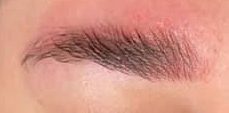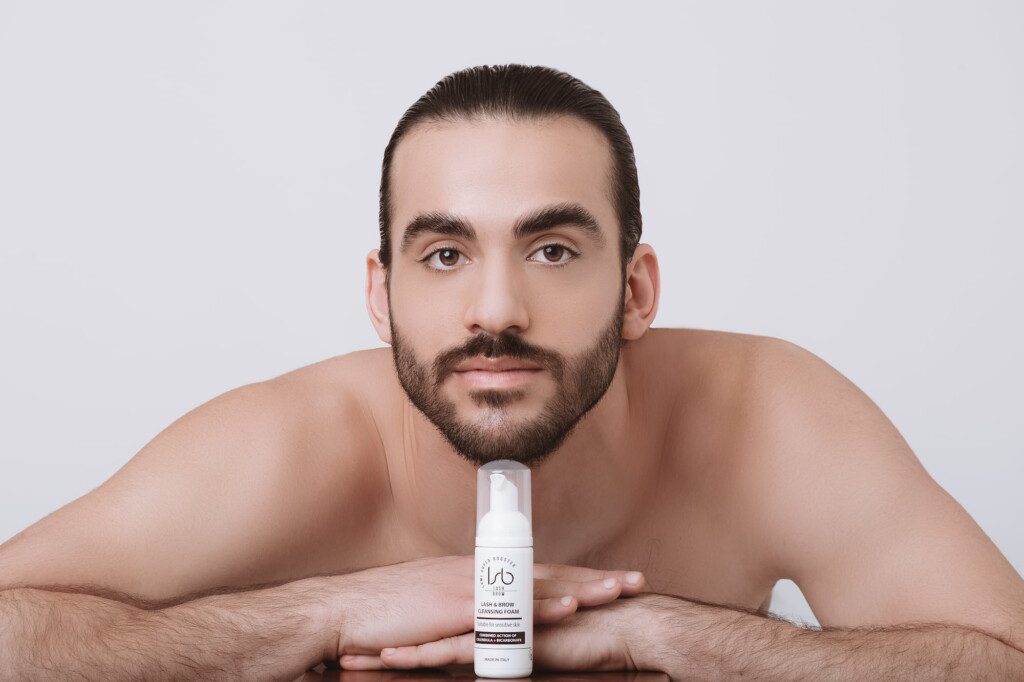Heart-Shaped Face
For heart-shaped faces, opt for soft, rounded arches with fuller brows to balance the wider forehead and narrow chin. This shape complements the natural contours of a heart-shaped face, creating a harmonious look. Keep the brows fluffy and full to match the widest part of the face, which helps to soften the overall appearance. Avoid sharp angles or overly thin brows, as these can accentuate the narrowness of the chin. Instead, focus on creating a gentle curve that follows the natural brow line. Brow lamination can be an excellent technique to achieve this fuller, fluffier look while maintaining a soft arch. Remember, the goal is to create balance and symmetry, so pay attention to both brows and ensure they complement each other.
Square-Shaped Face

Square faces benefit from higher, more curved arches to soften angular features and create a more balanced appearance. Create a gentle arch that lifts upward to balance the strong jawline, effectively elongating the face and reducing the appearance of squareness. When shaping brows for a square face, focus on creating a smooth, continuous curve rather than sharp angles. This approach helps to soften the overall facial structure and add a touch of femininity. Steer clear of sharp, angled brows or low-dipping tails which can emphasize squareness and make the face appear even more angular. Instead, aim for a gradual, upward slope that peaks slightly past the midpoint of the brow. This technique can help create the illusion of a more oval-shaped face, which is often considered the ideal face shape in beauty standards.
Round Face

Round faces look best with high, angled arches to add structure and length, creating a more defined and elongated appearance. For smaller round faces, opt for a sharper arch to provide maximum definition and create the illusion of a more angular face shape. The key is to create contrast with the natural roundness of the face. Avoid overly thick or fluffy brows, as these can make the face appear rounder and more youthful. Instead, focus on creating a clear, defined shape with a distinct peak. Brow lamination can be particularly helpful in achieving this look, as it allows for precise shaping and can help create the appearance of fuller, more structured brows. When shaping brows for a round face, pay special attention to the tail end, ensuring it extends slightly beyond the outer corner of the eye to further elongate the face.
Oval-Shaped Face

Oval faces are versatile and suit most brow shapes, making them the easiest to work with. Follow your natural brow line with soft, slight arches to enhance the natural balance of an oval face. The key is to maintain proportion and avoid disrupting the inherent harmony of oval face shapes. Gentle shaping is crucial for oval faces, as dramatic changes can upset the natural balance. Avoid dramatic shapes or straight wide brows that can disrupt oval proportions and make the face appear shorter or wider. Instead, focus on enhancing the natural brow shape with subtle grooming techniques. Brow lamination can be a great option for oval faces, as it allows for a natural-looking enhancement that maintains the face’s inherent proportions while adding definition and fullness to the brows.
Long/Oblong Face

For long faces, choose straighter brows with soft edges and a low-lying arch to help widen the face visually and create the illusion of a shorter, more balanced facial structure. This shape helps to counteract the elongated appearance of the face by drawing the eye outward rather than upward. Avoid high arches which can elongate the face further, as this will only emphasize the length of the face. Fuller brows work well to balance proportions on a long face, creating a sense of width and fullness that complements the facial structure. When shaping brows for a long face, focus on creating a gentle, horizontal line rather than a dramatic arch. This can be achieved through careful trimming and shaping, or with the help of brow lamination techniques. Remember to keep the tail of the brow from dropping too low, as this can drag the face down and emphasize its length.
Diamond-Shaped Face

Diamond faces benefit from curved brows with an angled arch to lengthen the forehead and balance the wider cheekbones. This shape helps to soften the angular features typical of diamond-shaped faces while creating a harmonious overall look. Keep the tail end soft rather than pointed to avoid emphasizing the narrow chin. The key is to create a shape that complements the natural angles of the face without adding more sharpness. Avoid an over-defined finish which can look harsh on diamond face shapes and instead opt for a softer, more natural appearance. When shaping brows for a diamond face, focus on creating a gentle curve that peaks just above the outer edge of the iris. This placement helps to draw attention to the eyes and create the illusion of a wider forehead. Brow lamination can be an excellent tool for achieving this look, as it allows for precise shaping and can help create the appearance of fuller, more defined brows without harsh lines.
General Tips
Choose a brow shape opposite to your face shape for balance. This principle helps create contrast and harmony in facial features. Let your natural brows guide the overall shape, especially for oval faces, as working with your natural brow line often yields the most flattering results. Aim for harmony between your natural brow bend and desired shape to ensure a look that’s both flattering and easy to maintain. Remember that brow trends come and go, but a shape that complements your unique facial features will always be in style. Regular maintenance is key to keeping your brows looking their best, whether through traditional grooming methods or more advanced techniques like brow lamination. Lastly, don’t be afraid to consult with a professional brow stylist who can provide personalized advice based on your specific face shape and features.





